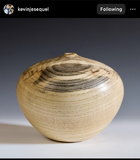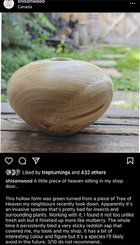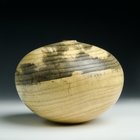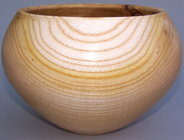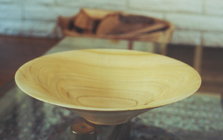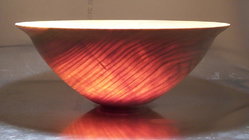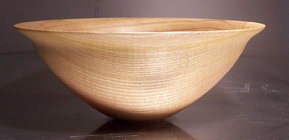Hi all,
I do not need help identifying this tenacious tree that seems bent on taking over my property. It is definitely ToH, with the peanut butter stink and all. I am just looking for some info before I waste any more time on the stuff than I already have.
I did some searching here, and elsewhere, and Robo says he turned some several years ago but didn't say much about it other than the pores, but I have not found a lot of info "out there" on the wood in terms of woodturning.
I tried to dry a dozen 6" logs several months ago but it molded over rather quickly and I tossed it all. I had sealed the ends with white glue, but the bark itself got moldy. My basement is not terribly damp; the maple right next to it did not get moldy. I'll figure out how to dry it later, if it has any real value.
I have some hope it will be useful to me as practice wood, if for nothing else, since I am a beginning to start being a beginner. Hard, stable wood might not be as good as soft wood fir training, and I can literally go out the door and harvest whenever I like without feeling like I am wasting other stock that is more difficult to procure. Softer woods are more challenging, so I hear, but that's a plus for training, IMO, unless it is simply too soft. I suppose it will not give me as much practice time at the grinder as red oak or hard maple would, but I can live with that.
Am I on the wrong track? I need to get the Tree of Heaven population knocked down regardless. Just wondering if it should even go to the lathe at all, and I am hoping it might even be slightly better than trash, perhaps even minimally useful. Maybe the pores could be put to some clever artistic use? Maybe it is even simply pleasant to work with.
Thanks in advance for sharing your opinions and experience.
I do not need help identifying this tenacious tree that seems bent on taking over my property. It is definitely ToH, with the peanut butter stink and all. I am just looking for some info before I waste any more time on the stuff than I already have.
I did some searching here, and elsewhere, and Robo says he turned some several years ago but didn't say much about it other than the pores, but I have not found a lot of info "out there" on the wood in terms of woodturning.
I tried to dry a dozen 6" logs several months ago but it molded over rather quickly and I tossed it all. I had sealed the ends with white glue, but the bark itself got moldy. My basement is not terribly damp; the maple right next to it did not get moldy. I'll figure out how to dry it later, if it has any real value.
I have some hope it will be useful to me as practice wood, if for nothing else, since I am a beginning to start being a beginner. Hard, stable wood might not be as good as soft wood fir training, and I can literally go out the door and harvest whenever I like without feeling like I am wasting other stock that is more difficult to procure. Softer woods are more challenging, so I hear, but that's a plus for training, IMO, unless it is simply too soft. I suppose it will not give me as much practice time at the grinder as red oak or hard maple would, but I can live with that.
Am I on the wrong track? I need to get the Tree of Heaven population knocked down regardless. Just wondering if it should even go to the lathe at all, and I am hoping it might even be slightly better than trash, perhaps even minimally useful. Maybe the pores could be put to some clever artistic use? Maybe it is even simply pleasant to work with.
Thanks in advance for sharing your opinions and experience.
Last edited:

